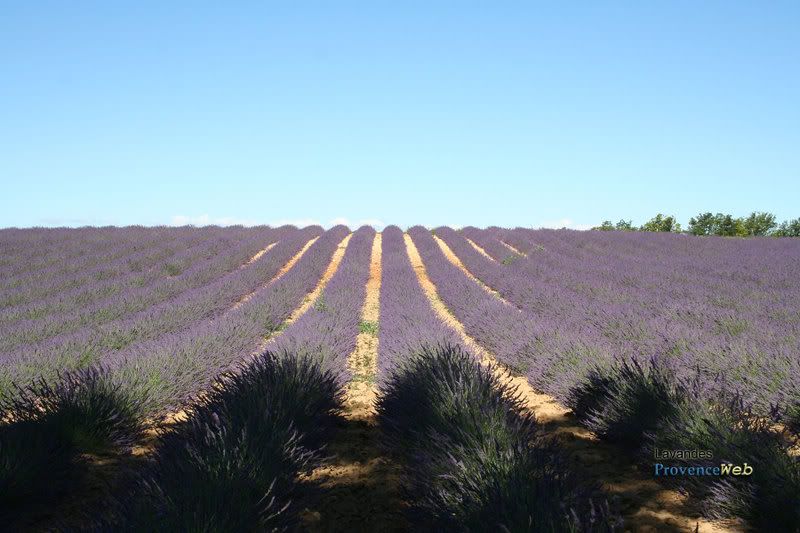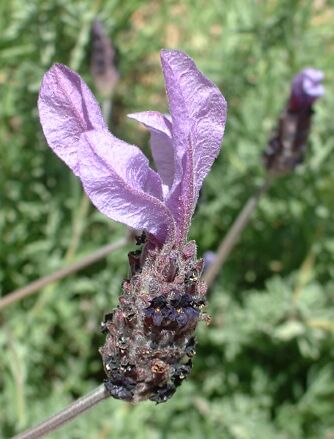
在眾多花草中,我也不知道為什麽我特別喜歡Lavender, 不是花卻更幽香,也非草卻能笑傲嚴寒,我自己在屋前屋後都種了不少,有english lavender; French lavender; Spanish lavender, 開花的季節也很長,整個夏秋季,嚴寒的冬天時,雖不開花,那小小尖尖的綠葉還是綠油油的。
在中國的家鄉,我從來都沒見過Lavander 薰衣草, ,小時候隻想遠走高飛,去看外麵的世界,卻從來也沒想過,長大了會來到美麗浪漫的法蘭西,一個盛產薰衣草的國度,並且成為她的一員。
法蘭西,你為什麽總讓我感受到新奇,溫柔,浪漫,是你的自由,文化,藝術?是陽光, 海灘,古堡,葡萄園,薰衣草幽香?還是你的感性(甚至任性),我想都是,當然還有精致的法國美食,時裝, deco, 巴黎街頭的咖啡館,還有。。。
我希望我心中的薰衣草樂園能遠離喧囂, 就好似在法國的南部,Provence 普羅旺斯 ,那裏有空氣,陽光,暖暖洋洋懶懶的陽光,古堡,農莊,撲鼻的熏衣草幽香,葡萄酒 和美麗的音樂。。。
Debussy "Preludes" 
The Lavenders Lavandula are a genus of about 25-30 species of flowering plants in the mint family, Lamiaceae, native to the Mediterranean region south to tropical Africa and to the southeast regions of India. The genus includes annuals, herbaceous plants, subshrubs, and small shrubs. The native range extends across the Canary Islands, North and East Africa, south Europe and the Mediterranean, Arabia, and India. Because the cultivated forms are planted in gardens world-wide, they are occasionally found growing wild, as garden escapees, well beyond their natural range.
Use
The most common species in cultivation is the Common Lavender Lavandula angustifolia (formerly L. officinalis). A wide range of cultivars can be found. Other commonly grown ornamental species are L. stoechas, L. dentata, and L. multifida.
Lavenders are widely grown in gardens. Flower spikes are used for dried flower arrangements. The fragrant, pale purple flowers and flower buds are used in potpourris. Dried and sealed in pouches, they are placed among stored items of clothing to give a fresh fragrance and as a deterrent to moths. The plant is also grown commercially for extraction of lavender oil from the flowers. This oil is used as an antiseptic and for aromatherapy.
Lavender flowers yield abundant nectar which yields a high quality honey for beekeepers. Lavender monofloral honey is produced primarily in the nations around the Mediterranean, and marketed worldwide as a premium product. Lavender flowers can be candied and are used as cake decoration. Lavender is also used as a herb, either alone or as an ingredient of herbes de Provence. Lavender is also used to flavour sugar, the product being called "lavender sugar", and the flowers are sometimes sold in a blend with black tea, as "lavender tea".
French chefs in and around Provence, France have been incorporating this herb into their cuisine for many centuries. Lavender lends a floral, slightly sweet and elegant flavour to most dishes. For most cooking applications it is the dried buds (also referred to as flowers) of lavender that are utilised, though some chefs experiment with the leaves as well. It is the buds however that contain the essential oil of lavender, which is where both the scent and flavour of lavender are best derived.
Medicinal use
English lavender, Lavandula angustifolia, yields a highly effective essential oil with very sweet overtones, and can be used in balms, salves, perfumes, cosmetics, and topical applications. Lavandin, Lavandula x intermedia (also known as French lavender), yields a similar essential oil, but with higher levels of terpenes including camphor, which add a sharper overtone to the fragrance. Spanish lavender, Lavandula stoechas is not used medicinally, but mainly for landscaping purposes.
Essential oil of lavender has antiseptic and anti-inflammatory properties. It was used in hospitals during WWI to disinfect floors, walls and other surfaces.
An infusion of lavender is claimed to soothe and heal insect bites. Bunches of lavender are also said to ward off insects. If applied to the temples, lavender oil is said to soothe headaches. Lavender is frequently used as an aid to sleep and relaxation: Seeds and flowers of the plant are added to pillows, and an infusion of three flowerheads added to a cup of boiling water are recommended as a soothing and relaxing bedtime drink. Lavender oil (or extract of Lavender) is claimed to heal acne when used diluted 1:10 with water, rosewater, or witch hazel; it is also used in the treatment of skin burns and inflammatory conditions (it is a traditional treatment for these in Iran).
Health precautions: There is scientific evidence to support the effectiveness of some of these remedies, especially the anti-inflammatory effects, but they should be used with caution since lavender oil can also be a powerful allergen. Ingesting lavender should be avoided during pregnancy and breastfeeding.[1].
Topically, lavender oil is cytotoxic as well as photosensitizing. A study demonstrated that lavender oil is cytotoxic to human skin cells in vitro (endothelial cells and fibroblasts) at a concentration of 0.25%. Linalool, a component of lavender oil, reflected the activity of the whole oil, indicating that linalool may be the active component of lavender oil [2]. The result of another study study showed that aqueous extracts reduced mitotic index, but induced chromosome aberrations and mitotic aberrations in comparison with control, significantly. Aqueous extracts induced breaks, stickiness, pole deviations and micronuclei. Furthermore, these effects were related to extract concentrations .
Gynaecomastia
Two essential oils, lavender and tea tree oil, have been implicated in causing gynaecomastia, an abnormal breast tissue growth in prepubescent boys. An article in the New England Journal of Medicine claimed that the use of shampoo and similar products, containing lavender and tea tree oils, in three boys resulted in this condition.[4] The authors were contacted, but have refused to identify the products used or discuss their work further. General knowledge of the formulas of such products, however, suggests that the levels of these materials could not have exceeded a few tenths of one percent--certainly not enough to produce any kind of adverse effects. However, a child hormone specialist at the University of Cambridge has claimed "... these oils can mimic oestrogens" and "people should be a little bit careful about using these products". [5][6]

History
The ancient Greeks called the lavender herb nardus, after the Syrian city of Naarda. It was also commonly called nard.
During Roman times, flowers were sold for 100 denarii per pound, which was about the same as a month's wages for a farm labourer, or fifty haircuts from the local barber. Lavender was commonly used in Roman baths to scent the water, and it was thought to restore the skin. Its late Latin name was lavandārius, from lavanda (things to be washed), from the verb lavāre (to wash).[7] When the Roman Empire conquered southern Britain, the Romans introduced lavender.
During the height of the Plague, glove makers at Grasse would scent their leathers with lavender oil, and this was claimed to ward off the Plague. This story could have some validity as the Plague was transmitted by fleas, which lavender is known to repel.
Former Manchester United striker Ruud Van Nistelrooy advocates the use of Lavender, and has been said to coat his boots in it prior to sleep.





